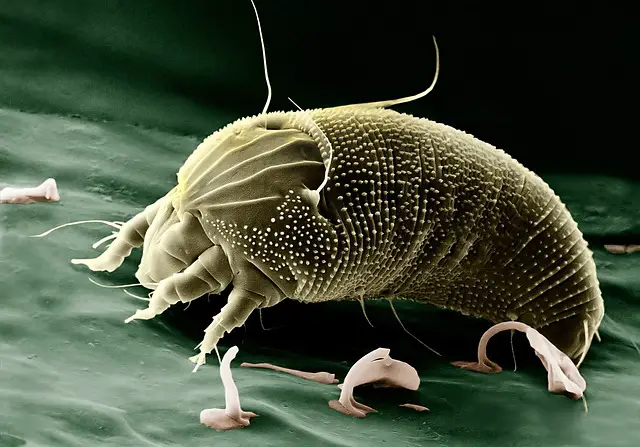Ear mites are the most common cause of ear infections in cats. These microscopic parasites feed on the oils and waxes from the cat’s ear, causing a range of symptoms, including itching, head shaking, redness, and discharge. So how do cats get infected with ear mites? Let’s explore this in more detail.
How do cats get ear mites?
Ear mites in cats are usually caused by an infestation of Otodectes cynotis, a common mite species that feeds off the wax, oils, and keratin in the ear canal.
Transmission from one cat to another is often through direct contact or shared grooming items. However, they can also be passed indirectly through contaminated bedding or furniture where infected debris accumulates.
It may even be possible for ear mites to spread on clothing when one brings a cat-infested environment into their home.
Treatment typically involves insecticides to kill the mites and accompanying bacteria and cleaning the infected area.
Therefore whenever furry members of our household experience consistent itching or irritation around their ears, it’s wise to make sure it’s not a sign of potential ear mite infestation.
Transmission of Ear Mites
Ear mite transmission is one of the most common ways a cat becomes infected with these parasites. Cats can pick up ear mites from other cats or animals through close contacts, such as during playtime or grooming sessions.
It’s also possible for a cat to pick up ear mites if it spends time outdoors where other animals may have been present.
Pet owners sometimes may even spread ear mites between their cats if they don’t take proper precautions when handling them.
Treatment for Ear Mites
If your cat has ear mites, you can try several different treatments.
One option is to use a topical ointment that contains an insecticide such as permethrin or pyrethrin.
This will kill the adult mites on contact and should be repeated every 3-4 weeks until all signs of infection are gone.
Another option is to use an oral medication such as ivermectin or milbemycin oxime, which will kill the adult mites and prevent any new ones from developing.
This should also be repeated every 3-4 weeks until all signs of infection are gone.
Additionally, you can use a flea comb to remove visible debris from your cat’s ears and clean them out with a saline solution.
This will help keep your cat’s ears free from debris that could attract more parasites and increase the risk of infection.
Finally, it’s important to remember that prevention is critical.
Make sure you regularly check your cat’s ears for signs of infection and take steps to protect them against potential sources of infection, such as other animals or outdoor areas where other animals may have been present.
Can a house cat get ear mites?
Ear mites are a widespread problem in cats, affecting domestic and feral cats alike.
An infestation happens when a cat is exposed to tiny mite parasites that feed on skin debris in the ears.
Contaminated bedding, grooming tools, toys, or even other cats can transmit these pesky pests. If your house cat is exhibiting signs of an ear mite infestation, such as a head shaking or scratching at its ears, it would be wise to seek professional attention from your vet.
If left untreated, ear mites can cause significant irritation, inflammation, and complications due to secondary bacterial or fungal infections.
The good news is that reliable treatments can eradicate adult mites and eggs from your pet’s environment, providing much-needed relief from symptoms within hours.
Can a house cat get ear mites if there are no other cats?
Yes, a house cat can indeed get ear mites without coming into contact with any other cats.
While not as common as when a cat is exposed to another infected cat or animal, ear mites are still possible.
Typically these cases occur when cats live in an environment with numerous small wildlife that also carries ear mites – such as rodents, rabbits, raccoons, and certain kinds of birds – these animals can become carriers of the itch-causing parasites and bring them into contact with your pet.
Any pet owner should monitor their pet’s ears carefully for signs of infestation, such as excessive scratching of the ears or head shaking, redness in the ears, and a black discharge that may be seen on the fur surrounding them. Prompt veterinary action is essential if the infestation is confirmed.
Conclusion
Ear mite transmission is one of the cats’ most common infection causes. Still, it can be prevented by taking proactive measures such as regular checkups and preventive treatments like topical ointments or oral medications that contain insecticides like permethrin or pyrethrin.
Additionally, cleaning out your cat’s ears with a saline solution and using a flea comb to remove debris can help reduce the risk of further reinfection. Finally, pet owners should monitor their cats for signs of infection so they can catch it early on before it becomes too severe! Taking these steps ensures that your beloved feline companion remains happy and healthy for years.
[su_box title=”Affiliate Disclosure”]This website is supported by its readers. Please assume that all links are affiliate links. If you make a purchase from one of the links we will make a commission from Amazon. Thank you.[/su_box]




